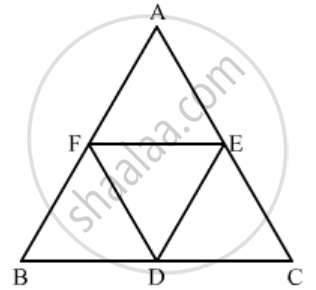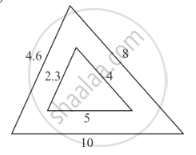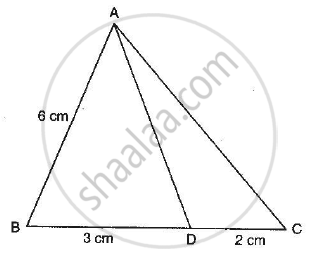Advertisements
Advertisements
प्रश्न
If D, E, F are the mid-points of sides BC, CA and AB respectively of ∆ABC, then the ratio of the areas of triangles DEF and ABC is
पर्याय
1 : 4
1 : 2
2 : 3
4 : 5
उत्तर
GIVEN: In ΔABC, D, E and F are the midpoints of BC, CA, and AB respectively.
TO FIND: Ratio of the areas of ΔDEF and ΔABC
Since it is given that D and, E are the midpoints of BC, and AC respectively.
Therefore DE || AB, DE || FA……(1)
Again it is given that D and, F are the midpoints of BC, and, AB respectively.
Therefore, DF || CA, DF || AE……(2)
From (1) and (2) we get AFDE is a parallelogram.
Similarly we can prove that BDEF is a parallelogram.
Now, in ΔADE and ΔABC
`∠FDE=∠A\text{(opposite angles of}||^(gm)AFDE)`
`∠DEF = ∠ B=\text{(opposite angles of}||^(gm)BDEF)`
`⇒ Δ ABC ∼ Δ DEF (\text{AA similarity criterion})`

We know that the ratio of areas of two similar triangles is equal to the ratio of squares of their corresponding sides.
`{ar(Δ DEF)}/{ar(Δ ABC)}=((DE)/(AB))^2`
`{ar(Δ DEF)}/{ar(Δ ABC)}=((1/2(AB))/(AB))^2(Since DE =1/2AB)`
`{ar(Δ DEF)}/{ar(Δ ABC)}=(1/4)`
Hence the correct option is `a`
APPEARS IN
संबंधित प्रश्न
A vertical stick of length 6 m casts a shadow 4 m long on the ground and at the same time a tower casts a shadow 28 m long. Find the height of the tower.
In ∆ABC, points P and Q are on CA and CB, respectively such that CA = 16 cm, CP = 10 cm, CB = 30 cm and CQ = 25 cm. Is PQ || AB?
In each of the following figures, you find who triangles. Indicate whether the triangles are similar. Give reasons in support of your answer.

Corresponding sides of two triangles are in the ratio 2 : 3. If the area of the smaller triangle is 48 cm2, determine the area of the larger triangle.
In ∆ABC, ∠C is an obtuse angle. AD ⊥ BC and AB2 = AC2 + 3 BC2. Prove that BC = CD.
In the adjoining figure, if AD is the bisector of ∠A, what is AC?

In the figure given below DE || BC. If AD = 2.4 cm, DB = 3.6 cm, AC = 5 cm. Find AE.
If ABC and DEF are similar triangles such that ∠A = 57° and ∠E = 73°, what is the measure of ∠C?
If ∆ABC and ∆DEF are similar such that 2AB = DE and BC = 8 cm, then EF =
If E is a point on side CA of an equilateral triangle ABC such that BE ⊥ CA, then AB2 + BC2 + CA2 =
